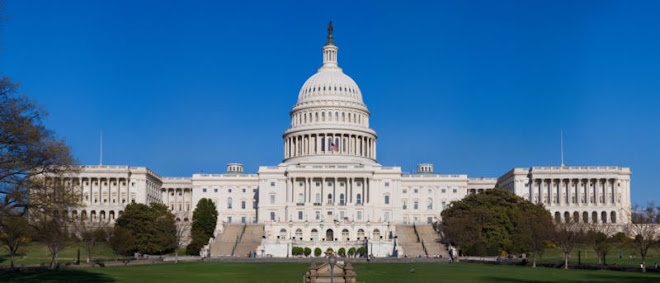From The American Thinker:
March 29, 2011
Another Fine Pension Mess
By Gary Jason
Amidst the raucous squawking occasioned by Obama's Kinetic Military Action in Libya, a story has gone unremarked in the general press. It concerns the pension tsunami that is looming at all levels of government.
The story is the flimsy state of the Pension Benefit Guaranty Corporation (PBGC). It is covered magisterially in a new paper written by the fine economist Charles Blahous of the Mercatus Center at George Mason University. Entitled "The 'Other' Pension Crisis: Options for Avoiding a Taxpayer Bailout of the PBGC," it is easily found on the internet, and is a real eye-popper.
The PBGC is an ill-conceived, federally chartered corporation, established in 1974 in the wake of several business failures that left their pension funds broke. Congress, in effect, set up an agency to guarantee pensions negotiated between private industry and private industry unions; the taxpayer would be the guarantor of last resort for particular private pension contracts.
As such, the PBGC wasn't just redundant (duplicating Social Security's initial purpose) but was and is the ultimate exercise in moral hazard. It encouraged unions to demand unsustainably high pension plans, and companies to grant them, because all parties knew that the U.S. would be there no matter what.
Blahous starts by reviewing the current unfunded liabilities facing the PBGC. Its single-employer pension insurance covers about 33.8 million workers in some 26,000 plans. If a plan fails, the PBGC assumes both its assets and its liabilities (obligations). The fund pays the employees their pensions, up to $55,000 a year. As of last year, it was already paying out about $5.6 billion to over 800,000 retirees.
Now, PBGC's official deficit -- the amount it is obligated to pay out not covered by its asset base -- stands at $21.6 billion, nearly the highest it has ever been. But Blahous notes that even the PBGC estimates that its "reasonably possible" risk (i.e., the underfunded liabilities of the plans with below investment grade ratings) is more like $170 billion. That is just for the single-employer pension plans. Last year, the "reasonably possible" risk in multi-employer plans was an additional $20 billion.
Worse, he notes that three years ago, the PBGC stopped estimating the total underfunding of all the pensions it covers. That is believed to be in the hundreds of billions of dollars, but the PBGC won't even try to guess.
To close even the projected pension deficits, the PBGC reckons that the yearly contributions companies have to make would have to increase five-fold over the next five years -- up to $250 billion annually -- rather than the current meager $50 billion.
After an extensive review of the various causes for this disastrous deficit, Blahous looks at three options for reforming the PBGC. The first option would be to give it the requisite tools to eliminate the shortfall. These would include the powers to change the premiums necessary to insure permanent solvency of the plans, and to set the rules plans must follow (such as a consistent amortization schedule for all plans to close the deficit). They would also involve enhancing the legal power the PBGC has to compel companies to contribute to their pensions, and to desist from actions that hurt those pensions, as well as making the PBGC an independent regulatory agency.
The second option would be to simply eliminate the PBGC, and instead require all pension plans to carry private insurance at full market rates. This would automatically address the issue of underfunding; the insurance companies would have to enforce proper funding, or risk massive losses in the event of having to take over in the event of a pension plan failure.
The third option would be to require that until the federal government chooses either of the first two options, the federal government must treat the PBGC deficit as an official liability of the federal government, to be factored into federal budgets.
Regarding the second option, Blahous notes most of us suspect that as long as the PBGC is a government entity, legislators will always be tempted to tinker with it at the behest of some favored union or protected industry, which will make it hard to enforce full-funding of its liabilities. But there is a problem with the idea of allowing private insurers to take over: what to do with the existing "legacy debt"? Try to force private insurance companies to collect not just enough in premiums to cover future liabilities, but the past deficit as well? Or have the taxpayers assume that debt outright?
Without adopting either of the first two options, i.e., by keeping the status quo, the nation is drifting towards a massive bailout of a huge number of pension plans. This would be grotesquely unfair. The four-fifths of American workers who do not have defined benefit plans would be responsible to pay through their taxes the plush pensions of the one-fifth of workers who do have such plans.
Would that mean the federal government would then guarantee all defined contribution plans (such as 401ks) against any value lost in stock market declines? How would the federal government -- already facing trillions of dollars in unfunded Social Security, Medicare, and Medicaid liabilities -- handle all that new debt?
Here is where the case for option #3 comes in. As long as we are as a nation liable for the future shortfalls of the PBGC, those liabilities should be honestly listed in our budgets. Perhaps seeing this will finally move the public towards one of the first two options -- preferably the second.
Of all the formidable challenges our country faces, the greatest one over the next decade will be dealing with the unfunded liabilities at both the state and federal levels. These liabilities are the cumulative consequence of 75 years of so-called progressive programs, and are exploding because of demographic changes, pushing the nation towards a fiscal cliff. The PBGC is a big part of this great challenge, and we all owe Blahous our gratitude for bringing us up to date.
Gary Jason is a contributing editor to Liberty and a philosophy instructor.
March 29, 2011
Another Fine Pension Mess
By Gary Jason
Amidst the raucous squawking occasioned by Obama's Kinetic Military Action in Libya, a story has gone unremarked in the general press. It concerns the pension tsunami that is looming at all levels of government.
The story is the flimsy state of the Pension Benefit Guaranty Corporation (PBGC). It is covered magisterially in a new paper written by the fine economist Charles Blahous of the Mercatus Center at George Mason University. Entitled "The 'Other' Pension Crisis: Options for Avoiding a Taxpayer Bailout of the PBGC," it is easily found on the internet, and is a real eye-popper.
The PBGC is an ill-conceived, federally chartered corporation, established in 1974 in the wake of several business failures that left their pension funds broke. Congress, in effect, set up an agency to guarantee pensions negotiated between private industry and private industry unions; the taxpayer would be the guarantor of last resort for particular private pension contracts.
As such, the PBGC wasn't just redundant (duplicating Social Security's initial purpose) but was and is the ultimate exercise in moral hazard. It encouraged unions to demand unsustainably high pension plans, and companies to grant them, because all parties knew that the U.S. would be there no matter what.
Blahous starts by reviewing the current unfunded liabilities facing the PBGC. Its single-employer pension insurance covers about 33.8 million workers in some 26,000 plans. If a plan fails, the PBGC assumes both its assets and its liabilities (obligations). The fund pays the employees their pensions, up to $55,000 a year. As of last year, it was already paying out about $5.6 billion to over 800,000 retirees.
Now, PBGC's official deficit -- the amount it is obligated to pay out not covered by its asset base -- stands at $21.6 billion, nearly the highest it has ever been. But Blahous notes that even the PBGC estimates that its "reasonably possible" risk (i.e., the underfunded liabilities of the plans with below investment grade ratings) is more like $170 billion. That is just for the single-employer pension plans. Last year, the "reasonably possible" risk in multi-employer plans was an additional $20 billion.
Worse, he notes that three years ago, the PBGC stopped estimating the total underfunding of all the pensions it covers. That is believed to be in the hundreds of billions of dollars, but the PBGC won't even try to guess.
To close even the projected pension deficits, the PBGC reckons that the yearly contributions companies have to make would have to increase five-fold over the next five years -- up to $250 billion annually -- rather than the current meager $50 billion.
After an extensive review of the various causes for this disastrous deficit, Blahous looks at three options for reforming the PBGC. The first option would be to give it the requisite tools to eliminate the shortfall. These would include the powers to change the premiums necessary to insure permanent solvency of the plans, and to set the rules plans must follow (such as a consistent amortization schedule for all plans to close the deficit). They would also involve enhancing the legal power the PBGC has to compel companies to contribute to their pensions, and to desist from actions that hurt those pensions, as well as making the PBGC an independent regulatory agency.
The second option would be to simply eliminate the PBGC, and instead require all pension plans to carry private insurance at full market rates. This would automatically address the issue of underfunding; the insurance companies would have to enforce proper funding, or risk massive losses in the event of having to take over in the event of a pension plan failure.
The third option would be to require that until the federal government chooses either of the first two options, the federal government must treat the PBGC deficit as an official liability of the federal government, to be factored into federal budgets.
Regarding the second option, Blahous notes most of us suspect that as long as the PBGC is a government entity, legislators will always be tempted to tinker with it at the behest of some favored union or protected industry, which will make it hard to enforce full-funding of its liabilities. But there is a problem with the idea of allowing private insurers to take over: what to do with the existing "legacy debt"? Try to force private insurance companies to collect not just enough in premiums to cover future liabilities, but the past deficit as well? Or have the taxpayers assume that debt outright?
Without adopting either of the first two options, i.e., by keeping the status quo, the nation is drifting towards a massive bailout of a huge number of pension plans. This would be grotesquely unfair. The four-fifths of American workers who do not have defined benefit plans would be responsible to pay through their taxes the plush pensions of the one-fifth of workers who do have such plans.
Would that mean the federal government would then guarantee all defined contribution plans (such as 401ks) against any value lost in stock market declines? How would the federal government -- already facing trillions of dollars in unfunded Social Security, Medicare, and Medicaid liabilities -- handle all that new debt?
Here is where the case for option #3 comes in. As long as we are as a nation liable for the future shortfalls of the PBGC, those liabilities should be honestly listed in our budgets. Perhaps seeing this will finally move the public towards one of the first two options -- preferably the second.
Of all the formidable challenges our country faces, the greatest one over the next decade will be dealing with the unfunded liabilities at both the state and federal levels. These liabilities are the cumulative consequence of 75 years of so-called progressive programs, and are exploding because of demographic changes, pushing the nation towards a fiscal cliff. The PBGC is a big part of this great challenge, and we all owe Blahous our gratitude for bringing us up to date.
Gary Jason is a contributing editor to Liberty and a philosophy instructor.










